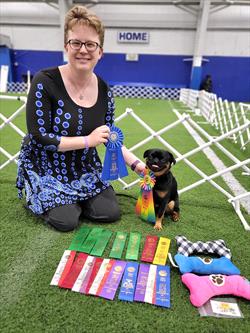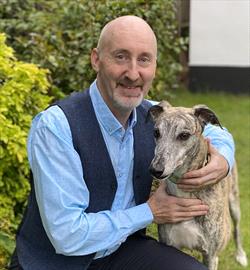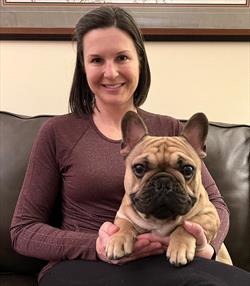
The ascent of a flat-faced dog as the most popular breed in America is stoking debate in the global veterinary community about whether such animals should even exist.
A short, broad skull with a snub snout, technically known as brachycephaly (brak-ee-SEH-fuh-lee), is found in dogs, including English bulldogs, French bulldogs, pugs and Boston terriers, and occurs in other animals, such as cats, rabbits and horses. The condition is associated with a host of health problems, but severity varies, and some brachycephalic animals lead healthy, happy lives.
Veterinarians long have been familiar with the kind of medical complications that can arise in flat-faced pets, whether it's breathing difficulties, skin infections or dental disease. Recent cultural changes, however, are bringing fresh urgency to discussions about their welfare.
The popularity of the so-called brachys is exploding worldwide. The Labrador retriever had been the most abundant dog breed in the United States for three decades until it was dethroned this year by the French bulldog, the American Kennel Club announced in March.
At the same time, some European countries, namely the Netherlands and Norway, have banned the reproduction of certain brachycephalic dogs for health reasons, fueling speculation that breeding bans could spread to other countries.
The clashing interests in the public arena are mirrored within the veterinary community. Some practitioners support breed bans. Some would like to eliminate or modify brachycephalic animals' signature traits through voluntary measures, such as working with breeders and through public education. And some question the premise that the breeds are inherently unhealthy, any more than many other breeds that are prone to disease, whether hip dysplasia or cancer.
To promote an open exchange of ideas on this hot-button issue, the VIN News Service invited six veterinarians from four countries to participate in a virtual roundtable, which took place on an electronic message board between May 8 and May 18.
Common to all was an understanding of love for brachys and shared heartbreak over the suffering many endure. Opinions varied, however, on what's driving that love, the uniformity of health problems, their root causes and how they might be prevented.
A story summing up the discussion follows. A lightly edited transcript can be viewed here.
To ban or not to ban?
In 2019, the Netherlands became the first country in the world to explicitly ban the breeding of dogs with short muzzles. It also is planning to ban the ownership of animals with harmful physical characteristics (not just their reproduction), and the "showing" of images of those animals, such as in advertising or on social media.
As a veterinarian at a busy animal hospital in the Netherlands, Dr. Marijn van Delden in Amsterdam has a front-row seat to how the changes are playing out. So far, she hasn't noticed much difference in her typical working day.
"We hear rumors that breeders are more stringent to which dogs they include in breeding programs, but we haven't noticed any change ourselves (yet)," she wrote.
Van Delden wholeheartedly supports her country's strict legislative approach. "We should go back to healthy proportions," she said. "If this is the way to motivate and convince breeders to change these external characteristics, then I'm all for it."
Also backing outright breed bans is Dr. Fraser Hale, a dental specialist in Guelph, Ontario, who in 2012 set up a public campaign called "Stop Brachycephalism, Now!"
It would be nice, he said, if animal lovers aware of the brachy's plight would avoid getting one, causing demand to dry up and breeders to simply stop breeding them.
"Unfortunately, humans do not seem to work that way," he said. "If they did, there would be no need for seat-belt laws or laws against drinking and driving. And there would be no need to ban ear-cropping, declawing and other cosmetic/convenience surgeries. The list goes on."
Hale supports legislation to require all brachycephalic pets be spayed or castrated so they cannot reproduce.
Dr. Carrie Stefaniak, a veterinarian in Port Washington, Wisconsin, and proud French bulldog owner, acknowledges that some brachycephalic animals experience health complications, but she would prefer to see those addressed via public education campaigns and one-on-one conversations between veterinarians and their clients.
"Breed bans seem impossible to enforce, and we have many more pressing legal issues in our country," she said. "Who in the world would enforce mandatory spay/neuter?"
Stefaniak doubts kennel clubs, such as the American Kennel Club, will deregister brachycephalic breeds any time soon, noting the surging popularity of the French bulldog and the revenue streams they generate. "To be clear, this isn't a positive thing," she said. "Popularity is never good for any breed, and unfortunately right now, French bulldogs are in the thick of things."
Dr. Heather Burrowes in Troy, New York, maintains that health problems associated with brachycephalism are the result of careless breeding practices. "A French bulldog from carefully selected lines is simply not going to have the same likelihood of problems as the less carefully tended genetics of a mass-production operation," she said.
Breeding bans, Burrowes said, would merely be a Band-Aid over what she sees as the much larger problem of poor public understanding of genetics. "The likely outcome of these bans will be to drive off conscientious breeders, produce unethical ones ('It's not a bulldog, it's a Swedish wrinkly terrier'), and overlook the presence of the healthy brachycephalic dogs in existence by placing an arbitrary correlation between muzzle length and health."
Dr. Milan Hess, a reproduction specialist based in Littleton, Colorado, would like to see a move away from extreme physical traits but stops short of backing breed bans.
"I believe the ship can be righted but it will take buy-in from the majority of veterinarians, breeders and consumers," Hess said. "Banning the breeds is not the answer in my opinion but we should be encouraging the movement towards anatomical normalcy through education, support for breeders trying to improve and refusing to breed dogs with anatomical extremes.
"I frequently tell people that dogs should have a Bill of Rights, including the right to breathe, breed and ambulate without difficulty or need for surgical intervention. It is something to strive for in all dogs."
Dr. Dan O'Neill in London, England, is dubious of the power of legislation alone to solve the problem, in part because he's skeptical that breed bans would be widely followed or adequately enforced.
O'Neill noted that brachycephalic animals are growing in popularity in the United Kingdom even though legislation there states that no dog should be bred if it can "reasonably be expected" that its offspring will experience health or welfare issues.
"So, sadly, for now, you may have to add me to the list of those who question whether legislation is the single solution to these human-emotional issues of brachycephaly in dogs," he said. "I think that steps to redress these major health and welfare issues in dogs need to be underpinned by robust legislation for sure, but legislation alone will not solve these problems that largely stem from value systems that we each carry in our own head."
Dr. Heather Burrowes

Photo courtesy of Dr. Heather Burrowes
Dr. Heather Burrowes of upstate New York has been working in general practice for 11 years. She is pictured with her Brussels griffon, Bender, at the 2022 New England Toy Dog Cluster.
Why are snub-nosed animals so appealing to humans?
Brachycephalic breeds such as French bulldogs aren't popular just in the U.S. They are becoming abundant in Canada, the U.K., Japan, Australia and many other countries.
Various reasons are offered for their appeal, most relating to their appearance.
"One factor is 'baby schema,' meaning that the flat face and large eyes suggest an infant human face, and we are hardwired to experience oxytocin release when we see an infant's face," said Hale, referring to the so-called love hormone that regulates warm human emotions.
The phenomenon, also known as kindchenschema, has been explored in several research papers, including this one.
The drive to own brachycephalic animals "lies so deeply in us" and is "hugely individual to each of us at any point in time," said O'Neill. "Our love of the look may overcome our concerns for the welfare price that these breeds pay for us to fulfill this love. But it is love, and is not easy to explain, for sure — it does not have to be rational."
The talk about the psychology of loving brachy breeds, along with implied questions about owners' judgment, motivation and moral character, made French bulldog owner Stefaniak uneasy. She expressed concern that it was condescending.
"I started to gravitate toward them due to their size, their easy-care coats, their wonderful engaging personalities, and their surprising athleticism," Stefaniak said.
Dr. Fraser Hale

Photo by Monica Forget
A recently retired veterinary dentistry specialist, Dr. Fraser Hale of Ontario province in Canada, has worked for more than a decade to raise awareness of health and well-being issues associated with flat-faced breeds.
"I got my first French bulldog in 2015, so I'm a relative newbie to this bandwagon. I call myself an advocate not because I think there should be more of them (I wish there were way fewer!) but because they aren't going away any time soon, and I try to do my best to care for them, and encourage others also to provide excellent standard of care for them."
Burrowes said she assumed ownership of a Brussels griffon after seeing "an incredibly broad swath of brachycephalic dogs" throughout her 11-year career, from pugs that could walk three miles on a warm day to pugs that struggled to make it from the couch to the food bowl.
"In becoming involved with the Brussels griffon breed, I've been amazed at how this quirky, rare breed with a small gene pool in the U.S. has so few 'brachy problems' relative to, say, our bulldog friends," she said. "And that has all been an ongoing education for me. If you had asked me in veterinary school if I would be the (proud!) owner of a brachycephalic dog 10 years into my career, I'd have laughed at you outright. And yet, here we are."
Burrowes allowed that many brachy animals can suffer from health problems — an acknowledgment that O'Neill said could indicate that brachy owners experience a degree of cognitive dissonance.
"Rationally, we can acknowledge and be aware of the issues, but at an emotional level, our love of the dogs with these looks can often be more powerful," he said.
Burrowes pushed back, maintaining that "the existence of my healthy dog doesn't justify the existence of unhealthy ones at all. My point is that brachycephalic anatomy is not a direct, irrefutable link to long-term suffering ..."
Other breeds suffer from health issues. Where do we draw the line?
Lots of breeds, not just the brachys, are known for certain health issues. Dachshunds are prone to back problems, for instance. Cancer is common in golden retrievers, Labrador retrievers and boxers, among others. Hip dysplasia is often associated with German shepherds. This begs the question of where a line should be drawn when considering which harmful physical traits in animals are acceptable, and which are not.
Stefaniak said she's seen good and bad representations of all dog breeds in more than two decades of clinical practice. The focus on brachycephalic animals strikes her as a "witch hunt of sorts."
"There are conscientious breeders that health test, breed for temperament and find educated homes for their puppies with families that are prepared for that particular breed," she said. "And then there are unscrupulous breeders that breed to capitalize on popularity, with no regard to health, structure or longevity of the dogs produced."
Owners, too, have a responsibility to be mindful of health risks in certain breeds, Stefaniak said. For example, she said a French bulldog with moderate breathing issues may not experience significant health problems if kept lean, fit and active.
"Many owners may not be prepared for their lifestyle needs and the financial implications of good veterinary care," she said. "But in my mind, it's no different than a person buying a Great Dane and then being unprepared for the $8,000 to $12,000 cost for its GDV [gastric dilation and volvulus] surgery and post-op care."
Van Delden agreed that many breeds experience serious health problems — to the extent that she is not a fan of purebred animals at all, much preferring cross-breeds.
"However, the poorly bred brachycephalic animals have breathing issues on an everyday basis, lifelong!” she exclaimed. "A GDV is horrible and life-threatening, but after successful surgery, these dogs can often live a healthy life again, not fighting for air."
For Hess, it all comes down to functionality and quality of life.
"Anatomical characteristics that are purposely bred, congenital and heritable, affecting normal breathing, ambulation, reproduction or causing pain would be top on my list of unacceptable traits," she said. This list would include not only anatomy associated with brachycephalic obstructive airways syndrome (BOAS), Hess added, but syringomyelia (a painful neurological condition), orthopedic disease and a wealth of others.
Dr. Milan Hess

Photo courtesy of Dr. Milan Hess
Dr. Milan Hess is a veterinary reproduction specialist and certified rehabilitation therapist in Colorado.
A second tier of characteristics that negatively impact the dog but in a less deleterious way, Hess said, include extreme hind-end angulation common in German shepherds and setters, and heavy facial folds in some mastiffs, brachycephalic breeds, shar-peis, bloodhounds and basset hounds.
"The good news is that all of the phenotypic traits are present and identifiable prior to considering the dog for inclusion in a breeding program, which means breeders can choose not to use them if they are aware of the problem and have the ethical wherewithal not to breed them," Hess said. More difficult conditions to prevent via selective breeding, she added, are those that crop up after a dog is bred, such as cancer, epilepsy, heart disease and diabetes mellitus.
O'Neill maintained that the scientific research, including his own at the Royal Veterinary College, "overwhelmingly" indicates that a large proportion of short-snouted animals experience health problems. "Yes, of course, there are very sick Labs (and every other breed), but when we compare the probability of diseases overall — also broken down by diseases related to the shape of these dogs that we as humans have chosen — there are much higher rates of disease in the French bulldog compared to other breeds such as the Labrador."
Unconvinced, Burrowes believes breeding practices are a big factor. "My clear and unambiguous message to clients, students and the public is health and function regardless of desired conformation," she said. "I support dogs that are bred naturally, function normally, and can breathe and live pain-free. This can happen with any conformation type ... just as its opposite can.
"To limit the focus to brachycephalic breeds does many other dogs a disservice and has a tendency to produce an 'us vs. them' mentality among dog owners and veterinarians that is not healthy for anyone."
Hale countered: "Yes, many purebreds have statistically higher risk of one problem or another than the general population, but we are not talking about others. This discussion is about brachys, and the fact that Labs might be prone to cancer does nothing to diminish the plight of so many brachys, and I see the comments about non-brachys as deflection.
"And the suggestion seems to be that since so many breeds have trouble, the problem is too big to tackle, so let's do nothing. Well, how do you eat an elephant? One bite at a time. We have to start somewhere, and since animals with extreme conformation have so many problems, they seem a good place to start."
To what extent does a flat face portend health problems?
A key bone of contention was whether possessing a flattened face should be directly assoiated with health problems, such as obstructed breathing and dental disease.
Not necessarily, argued Stefaniak, who noted that not all animals with short snouts struggle to breathe.
Over the past year, Stefaniak has been helping to bring to the U.S. a respiratory function grading (RFG) test of brachycephalic animals that was developed at the University of Cambridge in England. The test involves listening to breathing sounds made by a dog with a stethoscope before and after exercise, and then assigning a grade of severity based on those sounds. Applying the test, she said, could help breeders, veterinarians and dog lovers determine the best candidates for breeding.
Dr. Dan O'Neill

Photo courtesy of Dr. Dan O'Neill
Dr. Dan O'Neill is an associate professor in companion animal epidemiology at the Royal Veterinary College in London. He chairs the United Kingdom Brachycephalic Working Group. He is pictured here with a friend's rescue greyhound, Bruce.
"I don't believe you can make an assessment of an individual dog's functionality based on muzzle length or appearance alone," Stefaniak said. "I think it's important to discuss airways and to consider utilizing the RFG testing when making breeding decisions moving forward. The RFG is very new to this country, though, and will take some time to catch on."
Hess said she applauded efforts to bring RFG testing to the U.S. but wondered how often it would be carried out.
"Interestingly, when I began to require health testing prior to breeding any bitch, most of the bulldog/Frenchie people chose not to pursue health testing but to find another vet," she said. "So, while I think it is important, health testing requirements are only useful if the majority of veterinarians require them."
For his part, O'Neill posited that extreme physical characteristics, such as a flat face, increase the risk of health problems, period.
"Over the years, I have heard many justifications to keep breeding and owning dogs with extreme conformations. One that does keep coming up is that it is only the badly bred (however we define that term — a whole barrel of beer to discuss in its own right) dogs that are sick while the well-bred dogs are healthy. And although this is often repeated as though it is true, do we actually have any evidence on this?"
"Surely, the risk of disorders associated with extreme conformation is a function of the extremeness of the conformation," he said. "The health risks are baked into the extreme conformations unless we move towards moderation.”
Consequently, O’Neill feels that health testing should take multiple factors into account, including an animal's "innate health." Conformational features that carry innate health risks, he said, are "clearly visible, measurable and highly hereditable."
Hale drew on his experience as a dental specialist to argue the case that a short skull is a direct cause of suffering. He offered the example of malocclusion (misalignment of the teeth) that can cause discomfort, an inability to chew properly or close the mouth, and abnormal jaw growth.
"A short mouth with an even shorter maxilla simply cannot properly accommodate the teeth," he said. "It's a matter of 3D arithmetic."
The new breed ban in the Netherlands notwithstanding, Van Delden said she still frequently sees brachycephalic patients — mostly pugs, French bulldogs and English bulldogs. Often, she performs procedures to treat breathing difficulties, such as rhinoplasty, which involves changing the shape of the dog's nose, or partial staphylectomy, which involves removing tissue from its soft palate.
"Also, a lot of these dogs are on lifelong medication for stomach acid and regurgitation problems," she said. "About 70% of all veterinarian costs for these animals are due to breed-related issues."
Burrowes questioned whether scientific research has conclusively shown that brachycephalism causes poor quality of life. Moreover, she said, there is strong demand for "stable, predictable" purebred dogs. "That has been true for as long as dogs have been domesticated, and is not ever going to change."
"The downside of breeding to get this level of predictability is that it has genetic baggage that must be managed, whether we are talking about brachycephalic muzzles or hip dysplasia. That's one reason why I don't draw a distinction between brachycephalic conformation and any other aesthetic or functional quality that humans have selected dog breeds for. Is it harder to breed a healthy brachycephalic head conformation? Absolutely. That doesn't mean it can't be done or is unethical in and of itself."
What could kennel clubs and breeding groups do to address health issues?
What makes a brachycephalic breed brachycephalic? Although pet owners might have something to say about that, the official arbiters of breed classification are kennel clubs. And some of their breed definitions call for extreme structures.
For instance, the AKC standard for a pug's head is that it be "flat when viewed from the side," with a protruding nose judged "undesirable."
Some kennel clubs are making changes. In December 2021, the Kennel Club in the U.K. updated its standard for French bulldogs "to further underline the importance of avoiding extreme features that can lead to health problems."
Hess observed that changing breed standards to discourage extreme conformation could help ease animal suffering — eventually. "We would need a universal shift in our ideal for muzzle conformation, and some kennel clubs have already begun to change," she said.
Even still, old perceptions of perfection may die hard. Noting that the U.K.'s Kennel Club recently changed its English bulldog standard to penalize exaggerated features such as pinched nostrils and heavy skin wrinkles that obscure the eyes or nose, Hess said, "Unfortunately, this did not improve the appearance of the Crufts winner this year!" referring to the famed English dog show.
Burrowes would like to see kennel clubs at least show more concern about welfare issues associated with breed conformation.
"I do think that the breed parent clubs and national-level kennel clubs need to step up and bring conformational welfare issues to the forefront, and the AKC and American clubs have not been taking a leadership position here," she said.
Dr. Carrie Stefaniak

Photo courtesy of Dr. Carrie Stefaniak
Dr. Carrie Stefaniak of Wisconsin, shown with Kevin, one of her two French bulldogs, has practiced emergency veterinary medicine for 24 years. She advocates bringing a respiratory function test for brachycephalic breeds, developed in the U.K., to the U.S.
Stefaniak and O'Neill, though, questioned how much effect changed breed standards would have.
"About 1% of French bulldogs registered by the AKC are owned and bred by breed-club members,” Stefaniak said. "So, the other 99% (a staggering number) are owned by people that have never attended a dog show and likely do not even know a breed standard exists."
O'Neill said: "Breeders held the power to breed less extreme dogs a century ago when these breeds were being invented, but I am not sure that this power is now nearly as strong as it was back then."
"I think the power currently rests with the wider general public who can decide to ignore certain types of dogs such that they become almost nonexistent ... or who can choose to fall in love with certain other breeds who rise from nowhere to become the most popular breed in the land."
What is the role of veterinarians?
Their differences aside, most of the discussants agreed that veterinarians can play a big part in preventing health issues associated with brachycephalism.
"Veterinarians need to have honest discussions with owners of brachycephalics with extreme anatomy about their dogs' quality of life and encourage them to seek out Frenchies, bulldogs, Pekingese, etc., from breeders who are producing puppies from health-tested parents with functional anatomy," said Hess.
"Breeders seeking to improve their dog's functional anatomy should be supported, and we can decline to provide elective reproductive services to dogs with poor BOAS scores."
Hess also would like to see veterinarians avoid using representations of brachycephalic animals with extreme physical traits in their advertising materials. "We need to change the way we talk to people about the anatomical abnormalities affecting these dogs," she said. "It would be fantastic if we could have a famous spokesperson or large industry platform to help get the word out."
O'Neill agreed that education is important, though he believes demand for brachycephalic breeds is driven more by human emotions than ignorance of the science. "Normalization of typical negative welfare outcomes from extreme conformations in dogs is one of the greatest barriers to effective change," he said. "Humanity has bought into a collective belief that it is normal for extreme brachy dogs to have noisy breathing; indeed, it is almost expected that they will have noisy breathing as part of the joy of owning these dogs."
O'Neill noted that in the U.K., there are increasing efforts to reshape public perceptions about what's normal. The British Veterinary Association, for instance, recommends against using images of brachycephalic dogs in advertising and on social media.
Burrowes and Stefaniak spoke of steering their clients toward reputable breeders, while reminding them of their responsibilities as pet owners.
"I am relentless on weight control and fitness in my brachy patients," Burrowes said. "I spend exorbitant amounts of time on public education, hoping to catch owners prior to purchase and talk them out of carelessly bred animals near-guaranteed to have significant health issues."
Stefaniak said she believes veterinary professionals have a responsibility to talk openly about health issues and encourage better breeding practices.
"I am quick to try to educate owners," she said. "If their brachycephalic pet is obese, has horrible breathing, horrible skin, etc. … I tell them (in as gentle and as productive way as possible). I strongly encourage spay/neuter and have flat out (gently) told owners their dog should not be bred."
Van Delden was skeptical about how far public education can go. "During the course of my career, I have not seen any real change in how owners or breeders respond to veterinarians when we raise questions or give some factual information regarding the well-being of the brachys," she said. "In my experience, this will just result in the owners/breeders switching to another veterinary clinic."
Dr. Marijn van Delden

Photo courtesy of Dr. Marijn van Delden
Dr. Marijn van Delden practices at an animal hospital in Amsterdam, the Netherlands, where a ban on the breeding of dogs with short muzzles was introduced in 2019.
Van Delden added: "Of course, it would be preferable if we could change things by just informing the owners best as we can. So far, however, I don't see much difference by just keeping things in the advisory realm.
"So, will a ban in keeping these breeds be the solution? Well, at least it started this discussion. So hopefully, it will cause more discussion and awareness among breeders, and owners as well."
Hale pointed out that the Veterinarian's Oath in the U.S. compels practitioners to use their knowledge and skill to prevent and alleviate animal suffering. "An animal that is not yet conceived does not suffer from remaining unconceived, but since all brachys are at great risk of suffering as a result of their anatomy, we can prevent that suffering by preventing the conception," he said.
Still, he suspects some veterinarians may experience a "popularity paradox" — encouraging the ownership of animals with extreme physical characteristics because they don't want to upset clients and drive them away. "We risk our bottom line by being really honest with brachy owners, and this is a conflict of interest," he said.
Moreover, Hale said, the public has shown little appetite for education. Like Van Delden, he believes breed bans would more effectively capture people's attention.
Reflecting on the ultimate capacity for change, O'Neill drew attention to the broad range of opinions expressed during the roundtable discussion. "If even a small group of persons who have in-depth knowledge on canine health and breed-related issues cannot even reach a consensus on the existence of serious welfare issues related to brachycephaly, then should we really be that surprised that the wider world also holds highly discordant views?" he wrote.
Changing human perceptions of what is acceptable will require all stakeholders to work together "outside of our own silos," O'Neill said. "We also need to move from saying 'what not to do' towards instead saying 'what to do.' And we need to speak in human language more so than in scientific language."
One way to reframe the issue, he suggested, might involve moving away from thinking about what humans want in their dog and toward what brachycephalic animals might need in their life. "Suddenly, when we look at the issue from this perspective, we may start to put the likely welfare and health issues of the dog above our intrinsic prioritization of what we want, regardless of the cost to the dog."